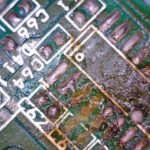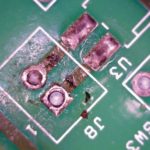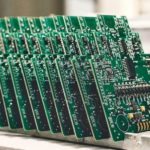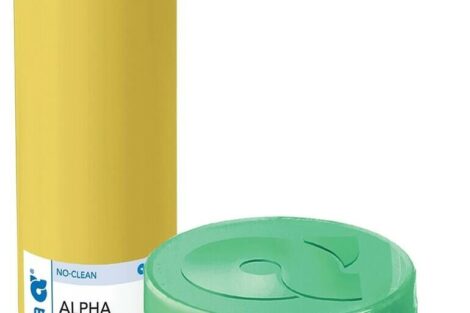Conformal coatings are designed to protect PCBs and ensure that they work efficiently in their end-use environment. However, there are instances where boards may not perform adequately or may even fail entirely despite being coated, which in turn produces an expensive, time-consuming nightmare that also impacts on reputations.
Causes of board failure
As electronics evolve to in an ever-smaller footprint, the chance of failures increase. As components get smaller and pitches become ever finer, many designs are getting closer to rule limits and sometimes even challenging the limits of manufacturability. It stands to reason, that the more designers push the boundaries, the chance of failure increases dramatically.
In addition to design related failure issues, the closer proximity of components due to the higher density inherently makes the hardware more vulnerable to corrosion, which is a complicated, diffusion controlled, electro-chemical process that takes place on an exposed metal surface, in the presence of water and ionic contaminants. Cleaning prior to conformal coating will go a long way to removing conditions for corrosion, enabling an efficient coating process to increase the insulation resistance in sensitive designs and mitigate against the effects of the operating environment on failure.
There are many variables that can potentially cause board failure. Some occur slowly, which can help with detection, maintenance and even repair, however, with an unanticipated failure mechanism, complete PCB failure is often more likely. When it fails despite being coated first, the chances are that there were problematic conditions already prevailing prior to the conformal coating process, further still, the coating itself could have been inappropriate or the method deployed was not suitable for the application. Equally, there are many other threats to a PCB’s success, which include applying conformal coating to components and surfaces that have not been cleaned, electrostatic discharge or even potentially poor construction of the unit itself.
Pre coat inspection
The most critical procedure to employ is to carry out an inspection prior to coating, as it validates the overall quality of the PCB, ensuring it is fit for purpose and in keeping with customer specifications. Inspection at this stage is also paramount in detecting any conditions that could potentially cause board failure such as component failure, insufficient board thickness and loose connections that impact on connectivity. Conformal coatings do have their limitations and contaminants present on the surface prior to coating will be sealed in by the operation, which may cause long term problems – such contaminants might include fingerprints, flux residues and moisture as well as other atmospheric pollutants. Boards should always be cleaned and dried before conformal coating to obtain optimum performance. Even when using so-called no-clean fluxes, cleaning boards before coating helps to increase performance and reliability.
Another renowned enemy of PCBs and components is heat. During operation, the materials within will undergo a wide range of temperature changes and each component has a specified range of heat that it can absorb, largely dependent on its size and shape. Higher power, greater density electronics produce more heat, which can cause mechanical stress that can impact on solder connections and burn out components. It is essential to manage heat transfer efficiently to increase the lifetime of the device and prevent failure. Overheating can also, in some cases, present a fire risk.
The continuing drive towards miniaturisation also means that there isn’t enough space for multiple boards. There is also an increase in designs utilising mixed technologies where analog, digital, and RF circuits are closely combined with high voltage circuits, which makes it difficult to satisfy both clearance and creepage requirements. Even slight changes in the environment, whether it is an increase in dust, higher humidity, water-splash, or exposure to gaseous materials can be enough to take an otherwise safe, functional design outside of safe operating clearance and creepage, and cause performance failures.
Electrolube’s UVCL coating increases durability of electric vehicle management system
Other contributing factors to failure include poor solder joints, unconsumed or superfluous flux and tin whiskers. Cold solder joints, which occur when the solder fails to melt, produce poor surface-mount connections that burn components. Left over flux can also contribute to corrosion, due to its absorption of moisture, and produce short circuits and damage to components. Tin whiskers also cause short circuits. Conformal coatings can normally combat the formation of tin whiskers but are less effective when they exist already prior to coating. In general, the level of mitigation provided depends more on coating coverage than its properties, although there is some equivocal data that show that harder and tougher coatings provide more mitigation, but this must be balanced with an increased impact on the life of the solder joint. Overall, focussing on achieving 100 % coverage of metal surfaces is likely to be a more efficient mitigation strategy.
Trace damage can occur from power surges, lightning strikes and overheating. Damage to the silver or copper conductive pathways can normally be seen with the naked eye, but this is not always the case. Trace damage causes issues with conductivity, components, and the reliability of the device. Fortunately, it is normally detected and remedied during the initial inspection as it is visually apparent.
Whilst this is not an exhaustive list of every single factor that contributes to PCB failure, it should help to provide an overview of key elements. Lastly, the design itself could be responsible for PCB failure. To increase the lifetime of the board, it is imperative to ensure that the appropriate components and materials have been selected, the board layout is sufficient, and the design is verified for its specific requirements. Design is also important in determining the appropriate coating application methodology and therefore the cycle times and the costs involved. Some simple things, like trying to keep connectors or non-coated areas on the same edge of the assembly, can make a difference to the ease of coating, the cost of coating and, of course, the overall reliability of the assembly.
PCB malfunction post coating
There are a number of variables that could be responsible for a malfunctioning PCB following the coating process. Generally, it could be poor product selection and/or application, an underlying problem arising from insufficient surface preparation or some chemical activity beneath the coating that is unrelated to its chemistry. Poorly performing coatings risk loss of insulation at the PCB surfaces when water condenses in combination with ionic impurities to form conductive pathways between PCB tracks. Without doubt, condensation can severely test the insulation resistance of a coating. There are many products that resist these sorts of conditions, so this type of problem can be avoided by making an appropriate material selection at the outset.
If the coating has not cured properly, it will not be able to develop its protective properties. In this incidence, the application process is to blame. Correct application is a pre-requisite to success and by achieving this, problems can also be directly solve. For instance, poor coverage, insufficient thickness, and sharp edge coverage can be difficult to ensure sufficient thickness to maintain protection. Material selection and application technique/workmanship will remedy these issues. The IPC specification allows a dry film thickness of between 30 and 130 microns, the greater thickness being achieved by multiple coating layers. Trying to achieve a 130 micron dry film thickness from a single process with a solvent-based acrylic material, for instance, is a recipe for a disaster, likely to result in excessive bubble formation, film shrinkage, coating de-lamination and additional stress on components. The result is poor protection, rather than an improved overall level of circuit protection. Aiming for a uniform 30–50 microns and focusing on achieving perfect coverage at each application is a better approach to improving the protection of electronic circuits.
Achieving the correct thickness is important; although if the coating is too thick, it can lead to entrapment of solvents in areas where the coating does not fully cure. Similarly, it can cause the coating to crack as it cures, or cause cracking of the coated components themselves, or as the result of changes in temperature, or due to mechanical shock and vibration. The number one determinant of reliable coating is in the application. Often a poor material applied well can be just as good or sometimes better than a material with great properties that is applied badly. Coating is about getting sufficient coverage of the sharp edges and metal surfaces without applying the material too thickly elsewhere. Of course, some materials ‘apply better’ than others and make this process as easy and fool proof as possible; but in the end, the performance of liquid applied coatings will always be determined by how well they were applied.
Large arrays of discrete components also represent a coating challenge due to the high levels of capillary forces present and the result can be disastrous, with areas of no coverage/protection and conversely areas of excessive thickness prone to stress-cracking, de-lamination and other defects. This can lead to premature failure of the assemblies and should be avoided if possible.
There may also be an unexpected interaction with other process material used to build the PCB. Flux residues are illustrative of this problem. In a ‘no-clean’ process, for example, these can inhibit the cure of some types of coating or lead to a loss of insulation of the system, greater than either material in isolation. Unless there has been meticulous attention to preparation or pre-coat cleaning regimes, corrosive residues bridging the PCB’s conducting tracks can, over time, cause failures.
The greatest test of conformal coating’s performance is posed during power-up under wet conditions, whether this is due to condensation, immersion, or salt-spray. Water with soluble impurities is electrically conductive and, finding any weak spots, will lead to short-circuits at the surface. In order to provide protection, it is essential to achieve 100 % defect-free coverage of the PCB’s metal surfaces, and this poses a real challenge for both the material itself and the application process. Fortunately, a new class of two-part conformal coating materials dubbed ‘2K’ enable a greater thickness and perfect application coverage to be achieved, resulting in a great level of protection. The performance advantages of Electrolube’s 2K coating materials, which combine the tough, resistant properties of an encapsulation resin with the easy application of a coating, have been positively demonstrated in three harsh tests, including powered condensation testing and powered immersion testing in salt-water.
Conclusion
PCBs are the life force of all electronic devices that we rely on every day, from smart phones, tablets, PCs and laptops to street lighting, TVs, refrigerators, microwaves, and cars. When it fails, it can be critically disruptive. Therefore, the materials selected to protect electronic assemblies can make or break a PCB, particularly if it is required to endure substantial physical shock and thermal cycles. Pre and post coating inspections and tests are essential to ensure that it will perform reliably and increase its lifetime, particularly if it will operate in a harsh environment.
Select the appropriate material for the protection required, apply and cure it well. Check for interactions with other process chemistries and thoroughly clean the assembly prior to coating. If possible, spend time simplifying the coating process at the design stage. By placing as many connectors and components that must not be coated as possible along one edge of the assembly, the coating application process will be simplified. PCB failures can unfortunately occur following the conformal coating application, but it can still be prevented with systematic pre-coat inspections, correct material selection/application method and further rigorous post-coating tests.
Electrolube
Ashby Park
Coalfield Way
Ashby de la Zouch
Leicestershire
LE65 1JR, United Kingdom
Tel.: +44 1 530 419600
E-Mail: info@hkw.us.com
Website: www.electrolube.com
Um sicherzustellen, dass eine konforme Beschichtung die gewünschten Anforderungen erfüllt, müssen die beschichteten Baugruppen über geeignete Testbedingungen einer Reihe von Umgebungen ausgesetzt werden, um den Leistungsbereich und die Grenzen zu ermitteln.
En vue de garantir qu’un revêtement conforme répond aux exigences souhaitées, les modules ayant reçu un revêtement de protection doivent être exposés à une série d’environnements en appliquant des conditions de test appropriées pour évaluer la plage de puissance et les limites.
Чтобы гарантировать, что конформное покрытие удовлетворяет необходимым требованиям, узлы с подобным покрытием должны быть подвергнуты воздействию различных сред в соответствующих условиях испытаний с целью определения диапазона рабочих характеристик и пределов.














